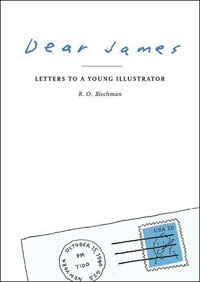
Dear James is R. O. Blechman’s entry into the “Letters to a Young Something-or-other” genre which has sprung up in imitation of Rainer Maria Rilke. In recent years books have been addressed to young mathematicians, young activists, young conservatives, and young novelists. The McSweeney’s website offers “Letters to a Young Plumber” and although I have not investigated this phenomenon in detail it would not surprise me if someone had written letters to a young rat-catcher.
No one seems to be writing letters to old people. It’s sad.
Anyway. Blechman is writing to a young illustrator. Not a real young illustrator, in this case, so it feels a little weird when he compliments his imaginary correspondent on his latest gig. But the conceit frees Blechman to take a casual, conversational tone and the book is more fun for it. That probably has a lot to do with why the “Letters” format has been popular lately.
Blechman touches on all the stages of an illustration from idea to print, and wider philosophical issues about art (How do you juggle creativity with a day job? What’s the difference, if any, between high art and low? And why are we doing this at all, anyway?). One idea that will be obvious to most artists but new to some readers is that art is work.
Not everybody gets this. For instance, there are people who think writers just sit down and, y’know, write. (There are writers who thing people just sit down and write. Recently I came across a blog post by a writer who claimed writing wasn’t work, it was just typing. I made a mental note to avoid his books.) These are the people who end up self-publishing horrid first-draft novels about elven vampires and cluttering slushpiles with nonsense.
There are people who think cartoonists and illustrators just draw. Maybe they’re especially fooled by scribbly and deceptively simple art like Blechman’s… but he wrestles with his ideas, draws multiple versions of an illustration, worries about the best and clearest way to communicate what he wants to get across. In one case, even after an illustration is accepted by the New York Times, he decides he hasn’t done his best work, and before the deadline he goes back to the editor with something better. It’s a struggle, but he’s also having fun. Dear James manages to communicate both the struggle and the fun.